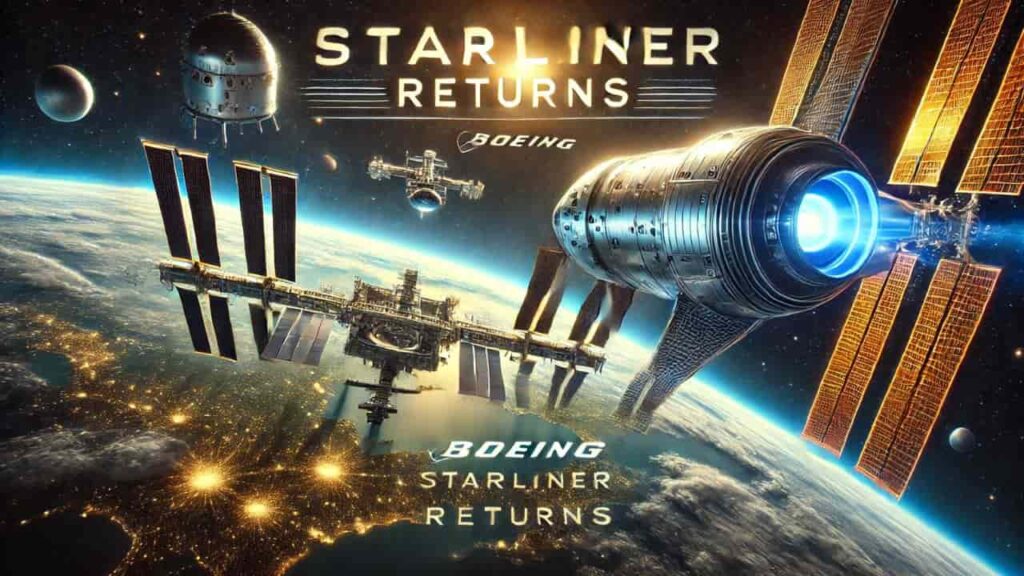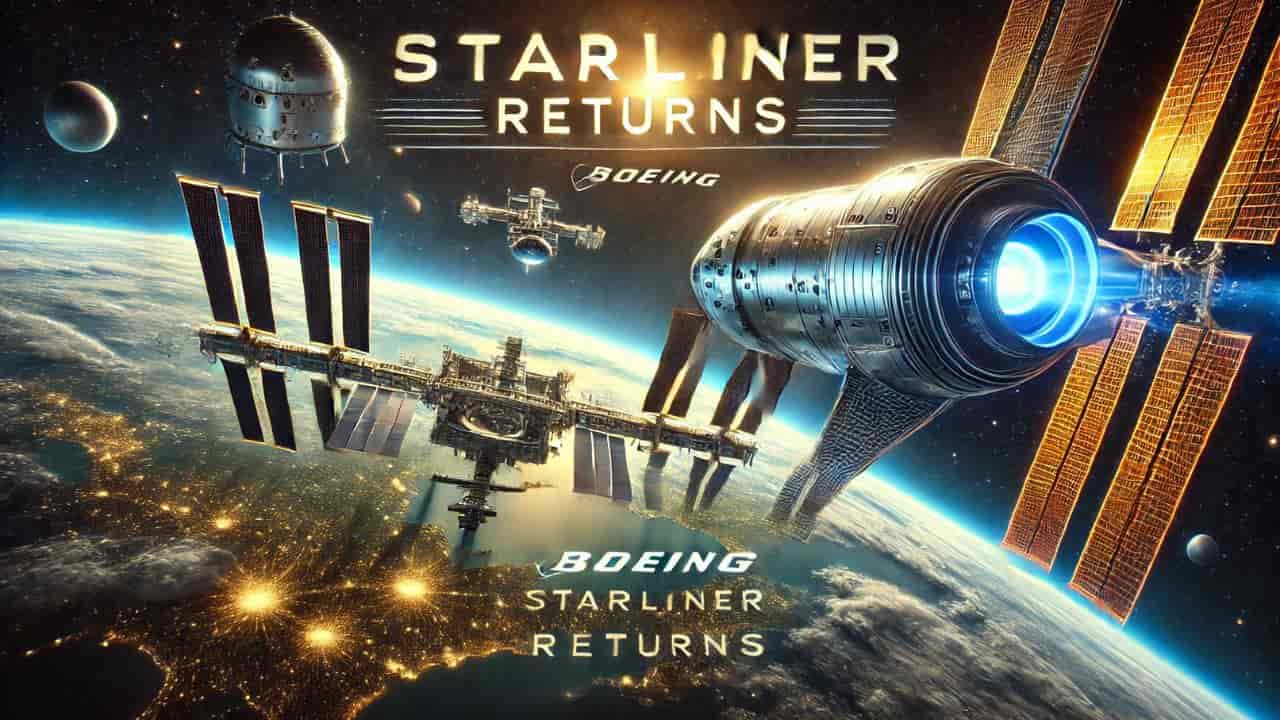Boeing Starliner, NASA Starliner spacecraft, Starliner return, Boeing Starliner challenges, NASA Commercial Crew Program, Starliner undocks ISS, Starliner spacecraft landing, NASA Boeing partnership, space exploration, ISS spacecraft return
Boeing’s Starliner spacecraft has undocked from the ISS and is heading back to Earth without NASA astronauts. Discover the challenges faced by the spacecraft and its role in NASA’s Commercial Crew Program. Learn about its future missions and how Boeing plans to address technical issues for upcoming space flights.

Boeing’s Starliner Spacecraft: A Pivotal Chapter in Space Exploration
Boeing’s Starliner spacecraft has recently embarked on a crucial journey back to Earth, signaling another key milestone in the partnership between NASA and private companies under the Commercial Crew Program. The spacecraft, which undocked from the International Space Station (ISS) on a Friday evening, is now making its way back to Earth. However, the return voyage is notably different from its earlier missions—it is happening without the NASA astronauts who initially flew it into space.
The Undocking Event: A Moment of Success
The Starliner successfully undocked from the ISS at 6:04 p.m. EST on Friday, and the entire event was broadcast live on NASA’s official channels. As the spacecraft cleared the space station, NASA’s live commentary announced, “OK, she’s on her way home.” The spacecraft’s return trip is set to conclude at White Sands Space Harbor in New Mexico, with an estimated landing time of 12:03 a.m. EST on Saturday, September 7. After this critical event, NASA and Boeing officials are expected to host a news conference to discuss the success of the mission and the next steps for Starliner.
Starliner’s First Crewed Test Flight and Its Challenges
This current return marks an important but incomplete chapter in Starliner’s journey, particularly concerning its human-crewed missions. Starliner carried NASA astronauts Barry “Butch” Wilmore and Sunita “Suni” Williams on its first crewed test flight. This mission was initially intended to last about a week after their lift-off on June 5, but complications forced NASA to push the astronauts’ return date. Instead of returning in Starliner, the astronauts will now come back in February 2025 aboard SpaceX’s Crew-9 Dragon spacecraft.
This delay was prompted by a variety of technical problems that have plagued Starliner throughout its mission. While the spacecraft managed to achieve its primary goal of safely reaching and docking with the ISS, multiple issues emerged that required careful troubleshooting. Wilmore and Williams were instrumental in preparing the Starliner for its return voyage, reconfiguring its seats for an uncrewed landing and packing it with cargo to be retrieved by ground crews. Additionally, they returned emergency hardware stowed inside the Starliner back to the ISS for future mission operations.
NASA’s Commercial Crew Program: Starliner’s Role
The Starliner spacecraft is part of NASA’s larger Commercial Crew Program, which was designed to certify private spacecraft for routine missions to and from the ISS. Boeing’s involvement in the program represented a crucial step toward reducing the dependency on government-run spacecraft and instead encouraging private companies to contribute to space exploration.
NASA officials, as well as those at Boeing, have expressed optimism about Starliner’s performance despite the setbacks it faced. Steve Stich, program manager for NASA’s Commercial Crew Program, commented during a news conference, “We have confidence in the vehicle… We’ve had two good landings so far, and we’re expecting another one on Friday.”
Pre-Launch Challenges: A Series of Delays
The road to the current mission has been anything but smooth for Starliner. Initially, its crewed flight test was scheduled for May 6, but this was postponed due to an oxygen valve issue in a rocket from United Launch Alliance (ULA), the company responsible for launching the spacecraft into orbit. As the problem required significant attention, the launch date was pushed back.
A new launch date of May 25 was set, but once again, technical difficulties surfaced. A helium leak was discovered in the service module, which houses vital support systems and instruments necessary for the spacecraft’s operations. This issue led to another delay, moving the launch to June 5, when the spacecraft finally lifted off. However, even after achieving liftoff, Starliner encountered additional problems. A thruster issue and several helium leaks were detected, further complicating the mission. Despite these challenges, NASA and Boeing ensured that the spacecraft had enough helium to complete its return journey successfully.
Mid-Mission Complications: Docking and Leaks
Following its docking at the ISS on June 6, the Starliner faced another hurdle. NASA and Boeing revealed that the spacecraft had developed five small helium leaks, raising concerns about its ability to complete the return mission. Although the leaks were minor, they posed potential risks. Fortunately, engineers determined that there was still enough helium on board to make the return trip without any serious delays.
To ensure the spacecraft’s thruster system would perform adequately during its departure from the ISS, teams at NASA’s White Sands Test Facility in New Mexico conducted ground tests last month. These tests simulated the conditions the spacecraft would face during undocking, giving engineers a clearer understanding of Starliner’s readiness for its journey back to Earth.
The Future of Starliner and Boeing’s Space Ambitions
The return of Boeing’s Starliner is a pivotal moment for both the company and NASA, especially in the context of the broader Commercial Crew Program. While SpaceX’s Crew Dragon has already demonstrated its capability in ferrying astronauts to and from the ISS, Boeing’s Starliner represents an alternative that could provide NASA with more flexibility and redundancy in its space exploration missions.
Despite the multiple delays and technical issues, Boeing and NASA remain committed to ensuring that Starliner becomes a fully certified and operational spacecraft. Once certified, Starliner is expected to perform regular missions to the ISS, offering NASA an additional spacecraft to complement SpaceX’s Crew Dragon.
This is crucial, as reliance on a single company for manned spaceflights could create bottlenecks or risks in the event of technical malfunctions. Having two certified spacecraft will offer NASA the redundancy it needs to maintain a continuous human presence in space, a key goal of the ISS program.
A Bumpy Road: Lessons from Starliner’s Development
Boeing’s journey with Starliner has been fraught with obstacles, from pre-launch issues to mid-mission complications. However, these setbacks have also provided valuable lessons for the company, NASA, and the broader space exploration community.
One of the primary lessons from Starliner’s experience is the importance of rigorous testing and redundancy in spacecraft systems. The helium leaks, thruster issues, and oxygen valve problems could have had far more serious consequences if not identified early. These issues underscore the need for continuous monitoring, testing, and improvement in spacecraft technology.
Moreover, the delays have highlighted the complexity of modern space exploration. Spacecraft like Starliner are incredibly sophisticated, with thousands of interconnected systems that must work in unison. A single malfunction, like a helium leak or thruster failure, can have a domino effect, jeopardizing the entire mission. The need for patience, persistence, and precision cannot be overstated when it comes to building spacecraft capable of carrying humans safely into space.
Conclusion: A Mission That Shapes the Future
Boeing’s Starliner spacecraft, despite the challenges it has faced, represents a significant step forward for NASA’s Commercial Crew Program and for private space exploration. While this current mission is uncrewed, the lessons learned and the successes achieved will pave the way for future manned missions.
With Boeing’s commitment to refining the spacecraft’s technology and addressing its problems, there is hope that Starliner will soon be a regular presence in NASA’s arsenal for manned spaceflights. The spacecraft’s ability to return safely to Earth will be a testament to the resilience and adaptability of modern space exploration technology.
Starliner’s journey is far from over, but with each milestone, Boeing moves closer to realizing its vision of making space travel more accessible and routine. The spacecraft’s performance in the coming days and months will be crucial in determining its future role in space exploration and its ability to meet NASA’s high standards. Whether it’s ferrying astronauts or cargo, Starliner is on the cusp of becoming a mainstay in NASA’s exploration missions, marking a new era for Boeing and for human spaceflight.
Read More
- NASA Astronaut Don Pettits Innovative Space Experiments A Journey of Discovery
- SpaceXs New Falcon 9 Booster Successfully Launches 22 Starlink Satellites Boosting Global Connectivity
- NASAs Europa Clipper Mission Exploring Jupiters Icy Moon for Signs of Life
- NASAs VIPER Moon Rover Exploring New Partnership Opportunities for Lunar Exploration










